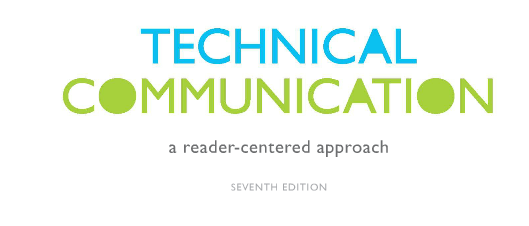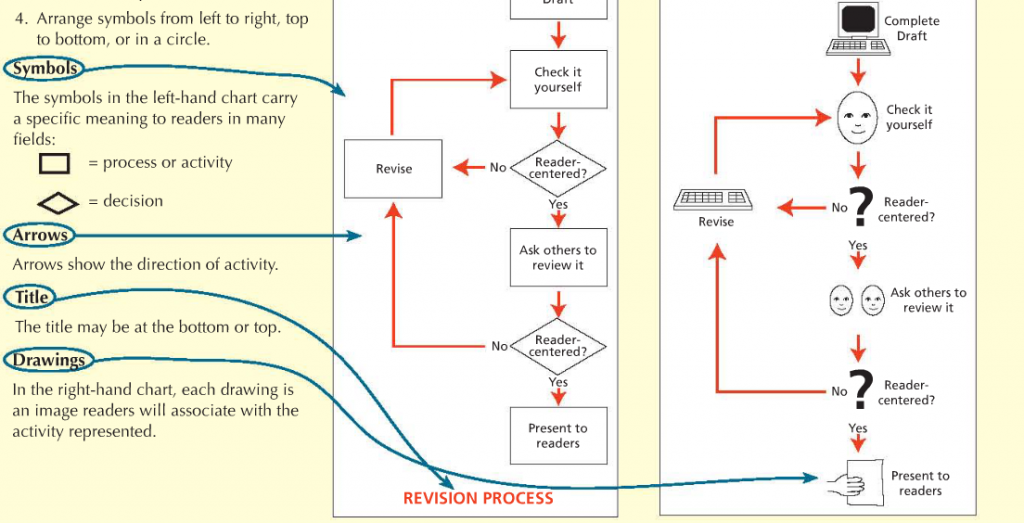Textbook Analysis; Technical Communication: A Reader Centered Approach by Paul V. Anderson
Introduction and Overview:
Technical Communication: A Reader Centered Approach purports the ability to take technical writing scenarios and give them an augmented sense of audience awareness by always focusing on creating a reader-centered approach. The book attempts to address a multitude of different documents, document parts (like graphics, headers, tables, etc.), and situations in which a tech writer may be producing documents and then discuss what potential obstacles the reader/audience member may bring to that writing situation. As Anderson (2011) states in his introduction: “When writing think constantly about your readers. Think about what they want from you—and why” (p. 11).
Writing Process:
Process is emphasized in the book both by demonstrating steps needed to write any number of documents or parts of documents (like front or back matter) alongside the arrangement of chapters that guide the user, reader, or instructor to address documents in a particular order. In Anderson’s case, the book begins with resumes and moves towards more official reports like feasibility reports and empirical research reports near the end.
Anderson shows the process for documents and document components in “writer’s tutorials,” which are purple highlighted sections throughout the book that guide students in a step-by-step process. He does this with a resume, showing where to add borders, tables and how to organize the information; editing graphics and pictures for the sake of web-based documents is another area Anderson focuses on for a tutorial.
Rhetoric, Persuasion, and Theory:
Rhetoric does not have an official representation in Anderson’s book (there’s not even an entry in the index for rhetoric and the word only appears in article names cited in the bibliography), but some key rhetorical concepts, ethos, logos, and pathos, terms that hardly come up again throughout the book are addressed briefly in the chapter regarding persuasion. Indirectly, however, the concepts of Rhetoric are emphasized throughout the book with the constant focus towards potential readers. Anderson does talk about logical fallacies in his discussion of writing documents that utilize cause and effect, but only mentions “post hoc” and “overgeneralization” as two of many other fallacies (p. 254).
Anderson gives the same treatment to other theoretical issues like ethics and mostly isolates discussions of ethics to chapter-end exercises and doesn’t dedicate a full chapter to either ethics or rhetoric. For instance, Anderson addresses ethics briefly in the introduction claiming, “a basic challenge facing anyone addressing ethical issues in workplace settings is that different people have different views of the right actions to take in various situations” (p. 21). Those “situations” however are only really ever addressed in Anderson’s made-up situations instead of in real problems that actually happened or have been studied. Additionally, the situational approach to ethics doesn’t necessarily help students understand the broad theoretical presence of ethics in technical documents.
Document Design:
Anderson emphasizes design in several chapters of his book. He discusses the integration of graphics, coloring, and structuring of a document. This often involves showing examples that Anderson dissects with arrows and commentary in the margins about what kinds of strategies are employed in each kind of document. A basic example of this is the difference between what Anderson calls an experiential resume versus a skill-based resume found scattered throughout chapter 2.
Anderson also has several chapters near the end of the book where he discusses what he calls the “super structures.” In these final chapters, he takes time to break down the elements and give more specific examples of technical documents including memos, proposals, and reports. Unfortunately, this appears inconveniently at the end of the book while ironically being the most useful part of the book.
Visuals:
Visuals permeate the book with examples of documents and pictures of finished products. Anderson, however, does a poor job following his own advice to “use bright colors to focus your reader’s attention” (advice linked the image below) and overdoes and over-colors the textbook to the point it’s impossible to look at any given page and understand what is most important to understand.
Pages 368 and 374 are perfect examples of the confusion that occurs as a result of over-styling or over-marking the page. This kind of problem can also be observed on the opening page of any particular chapter (374 Shown below).
Technology:
Anderson has sections where he discusses writing in digital mediums and his book comes with an online component that offers both an interactive version of the textbook (which it turns out, basically means it’s searchable, but not much else) and there are additional quizzes and case scenarios online. The problem is that these scenarios and online components add almost nothing to the book or the course since the electronic book, aside from the ability to use electronic search functions, offers an experience almost identical to the paperback copy. Additionally, the case scenarios, instead of referencing real problems, are often Anderson’s own wonky creations that often emphasize his inelegant sense of dialogue instead of investigating real technical issues that would hold more utility and practicality to students of technical writing. A prime example of Anderson’s approach to case studies is his example of addressing ethical issues in a scientific workplace work place: the scenario consists largely of a long, droll conversation between two colleagues about how to address their superiors about misgivings regarding animal testing, full of detail irrelevant to the actual writing task at hand.
Conclusions:
Anderson’s book, especially with the Instructor Companion book, is a fine resource for first time technical writing teachers, but its inability to focus on actual real-life scenarios or theory, and its ad nauseam focus towards reader-centered approaches (which are often obvious and droll) will inevitably lead teachers to supplement the text with a great deal of other readings both technical and scholarly. In short, this book makes for a great starting point for those not fully familiar or comfortable with technical writing, but you will owe it to yourself and your students to find something better suited to technical writing in subsequent semesters.
Works Cited:
Anderson, P. V. (2010). Technical Communication (7th ed.). Wadsworth Publishing.



